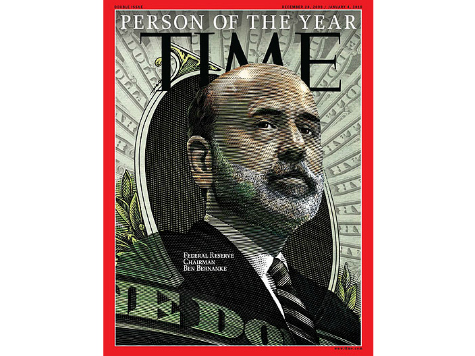
Time magazine awarded Federal Reserve Chair Ben Bernanke Man of the Year for his efforts that led the Fed to buy $3 trillion in bonds and mortgages to push up prices on the securities markets in order to create a “wealth effect”. Bernanke’s “quantitative easing” (QE) was supposed to put more money in circulation to encourage people to consume. This may have worked for “people” who are hedge fund billionaires that benefited from this flood of cash’s pushing up the price of oil, but to “regular people,” QE acted like a new tax on gasoline and hammered down their disposable incomes by about 5-10%. As the Fed continues to “taper” off of this welfare for fat cats, gasoline prices will fall and most American’s disposable incomes will rise.
The US Federal Reserve held about $800 billion of Treasury notes on its balance sheet before Lehman Brothers filed bankruptcy in September of 2008 and started the great recession. The Federal Reserve announced it intended to buy $600 billion in mortgage-backed securities and an undisclosed amount of Treasury bonds to bring stability to U.S. securities markets.
By March 2009, the Fed announced it was holding $1.75 trillion of bank debt, mortgage-backed securities, and Treasury notes. At the time, a barrel of U.S. oil was trading at $49.64 and the Dow Jones Industrial Average of stocks was trading at 7,608; the panic was over and securities markets started moving up.
But inexplicably, the Fed bought another $350 billion in securities by November of 2010. The new Fed purchases drove the DJIA up by 31% to 11,006, but it also drove the price of oil up by over 64% to $81.57 a barrel.
Fed Chair Bernanke in his November 5, 2010 speech said, “Lower corporate bond rates will encourage investment. And higher stock prices will boost consumer wealth and help increase confidence, which can also spur spending. Increased spending will lead to higher incomes and profits that, in a virtuous circle, will further support economic expansion.”
With Bernanke feeling good about his success on Wall Street, the Fed announced a second round of quantitative easing called QE2 to buy $600 billion of Treasury securities by June of 2011. By June 2011, the DJIA moved up another 8.1% to 12,414, but the price of oil moved up to by 14.9% to $93.70.
Feeling even better about his success on Wall Street, in September 2012 Bernanke announced a third quantitative easing, “QE3,” to buy about $1 trillion of securities a year. When the program peaked in June 2013 and the Fed said it would begin “tapering their securities purchases,” the DJIA was up another 4% to 12,881, but oil was unchanged at $93.81.
Research showed that “rises in gasoline expenditures during [a] period rise one for one with increases in gasoline prices.” As “gasoline prices increase by 100 percent,” the quantity consumers spend on other goods “falls on average by 5-10 percent.”
Few economic analyses are easier to understand than that each round of the Federal Reserve’s quantitative easing after the 2008 to 2009 financial crisis hurt the average American’s disposable income. Since the announced end of the QE in October 2013, oil prices have been falling, while employment and production have been rising. It doesn’t take a degree in math to understand this relationship.

COMMENTS
Please let us know if you're having issues with commenting.